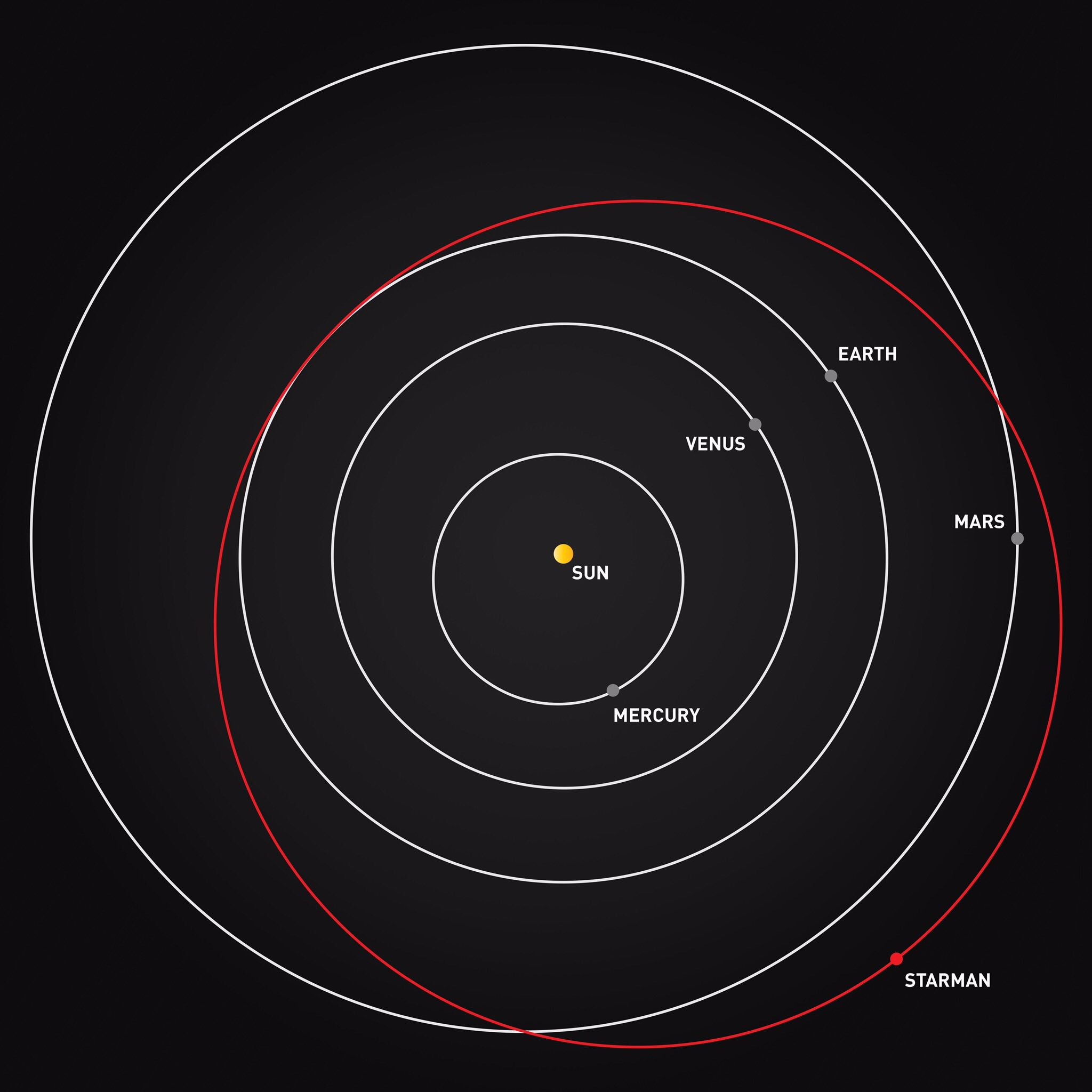SpaceX's 'Starman' and Its Tesla Roadster Are Now Beyond Mars
Starman has put a lot of miles on his Tesla Roadster in the last nine months.
The red electric car and its spacesuit-clad mannequin driver, which launched on the maiden mission of SpaceX's huge Falcon Heavy rocket in February, have made it beyond the orbit of Mars, company representatives said Friday night (Nov. 2).
"Starman's current location. Next stop, the restaurant at the end of the universe," SpaceX posted on Twitter Friday, along with an orbit diagram. [Epic SpaceX Road Trip Photos: Starman Rides a Tesla Roadster in Space]
The second sentence of that tweet, of course, is a nod to the late, great writer Douglas Adams. "The Restaurant at the End of the Universe" is the second novel in Adams' five-part "Hitchhiker's Guide to the Galaxy" series.
Like many of us, SpaceX founder and CEO Elon Musk is a big "Hitchhiker's Guide" fan, as Starman's Roadster shows. The car's entertainment display was programmed to read "Don't Panic!" — the phrase that adorns the cover of the eponymous electronic guidebook in Adams' beloved series.
"Starman" is a cultural reference as well; it's the title of a1972 song by David Bowie. And Musk said before launch that the Roadster would play Bowie's 1969 hit "Space Oddity" at full blast during its deep-space trek (though Starman cannot hear the famous tune in the airless void). Ultimately, Musk opted for Bowie's "Life on Mars" as parting music for Starman and the Tesla.
Related: Track Tesla in Space
Breaking space news, the latest updates on rocket launches, skywatching events and more!
Musk has said that he launched the Roadster and Starman because the duo is a lot more fun than the typical inert-mass dummy payload (pun intended; sorry). Launching a satellite or other valuable spacecraft wasn't an option, given the risks inherent in maiden flights. (Musk also runs Tesla, so publicity was probably a factor as well.)
Starman and his ride — which once belonged to Musk — won't stay beyond Mars forever. As you can see in the diagram, the pair will loop back on their heliocentric orbit, eventually coming about as close to the sun as Earth does.
The Roadster and Starman will come within a few hundred thousand kilometers of our planet in 2091, according to an orbit-modeling study. The authors of that study determined that the car will slam into either Venus or Earth, likely within the next few tens of millions of years. They give the space car a 6 percent chance of hitting Earth in the next 1 million years, and a 2.5 percent chance of smacking Venus in that span. [In Photos: SpaceX's 1st Falcon Heavy Rocket Test Launch Success!]
You can track the space mannequin and cosmic Tesla at whereisroadster.com, a website created by Ben Pearson, founder of Old Ham Media.
The Falcon Heavy's second mission, which will launch the Saudi Arabian communications satellite Arabsat-6A to geostationary orbit, is scheduled for January 2019.
Mike Wall's book about the search for alien life, "Out There," will be published on Nov. 13 by Grand Central Publishing. Follow him on Twitter @michaeldwall. Follow us @Spacedotcom or Facebook. Originally published on Space.com.

Michael Wall is a Senior Space Writer with Space.com and joined the team in 2010. He primarily covers exoplanets, spaceflight and military space, but has been known to dabble in the space art beat. His book about the search for alien life, "Out There," was published on Nov. 13, 2018. Before becoming a science writer, Michael worked as a herpetologist and wildlife biologist. He has a Ph.D. in evolutionary biology from the University of Sydney, Australia, a bachelor's degree from the University of Arizona, and a graduate certificate in science writing from the University of California, Santa Cruz. To find out what his latest project is, you can follow Michael on Twitter.


